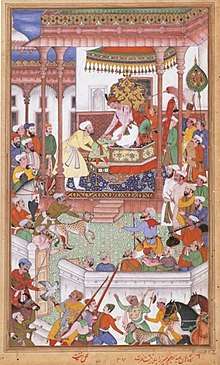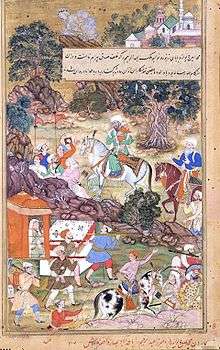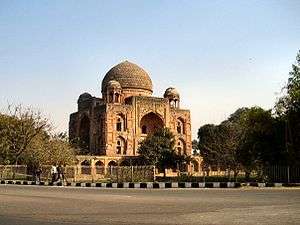Abdul Rahim Khan-I-Khana
Khanzada Mirza Khan Abdul Rahim Khan-e-Khana (17 December 1556 – 1 October 1627), also known as Rahim, was a poet who lived during the rule of Mughal emperor Akbar. He was one of the nine important ministers (dewan) in his court, also known as the Navaratnas. Rahim is known for his Hindi dohe (couplets)[1] and his books on astrology.[2] The village of Khan Khana, which is named after him, is located in the Nawanshahr district of the state of Punjab, India.
| Abdul Rahim | |
|---|---|
 Young Abdul Rahim Khan-I-Khana being received by Akbar | |
| Born | 17 December 1556 Delhi, Mughal empire |
| Died | 1 October 1627 (aged 70) Agra, Mughal empire |
| Burial | Tomb of Abdul Rahim Khan-i-Khana, Delhi |
| Spouse | Mah Banu Begum |
| Issue | Jana Begum Two sons |
| House | Baharlu |
| Father | Bairam Khan |
| Mother | Daughter of Jamal Khan |
| Religion | Islam |
Biography

Abdul Rahim was the son of Bairam Khan, Akbar's trusted guardian and mentor, who was of Turkic ancestry. When Humayun returned to India from his exile, he asked his nobles to forge matrimonial alliances with various zamindars and feudal lords across the nation. Humayun married the elder daughter of Khanzada Jamal Khan of Mewat (present Nuh district of Haryana) and he asked Bairam Khan to marry the younger daughter.
Gazetteer of Ulwur (Alwar) states:
- After Babur's death his successor, Humayun, in 1513 was supplanted as ruler by the Pathan Sher Shah Suri, who, in 1545, was followed by Islam Shah. During the reign of the latter, a battle was fought and lost by the emperor's troops at Firozpur Jhirka, in Mewat. However, Islam Shah did not lose his hold on power. Adil Shah, the third of the Pathan interlopers, who succeeded Islam Shah in 1552, had to contend for the empire with Humayun.[3]
- In these struggles for the restoration of Babur's dynasty Khanzadas apparently do not figure at all. Humayun seems to have conciliated them by marrying the elder daughter of Khanzada Jamal Khan, nephew of Babur's opponent, Khanzada Hasan Khan Mewati, and by requiring his minister, Bairam Khan, to marry the younger daughter of the same Mewati.[3]
Khanzadahs,[4] the royal family of Muslim Jadon (also spelt as Jadaun) Rajputs, converted to Islam after Islamic conquest of northern India.[5] Khanzadah, the Persian form of the Indic word 'Rajput'. Khanzadas were believed to have converted from a branch of Hindu Rajputs. They were the Mewatti Chiefs of the Persian historians, who were the representatives of the ancient Lords of Mewat State.[6]
Khanzadah, or "the son of a Khan" is precisely the Musalman equivalent to the Hindu Rajput or "son of a Raja " ...
Abdul Rahim was born in Delhi (Indian NCT)[8] to Bairam Khan and the daughter of Jamal Khan of Mewat of modern-day Haryana.
After Bairam Khan was murdered in Patan, Gujarat, his first wife and young Rahim were brought safely from Delhi to Ahmedabad and presented at the royal court of Akbar, who gave him the title of 'Mirza Khan', and subsequently married him to Mah Banu(MoonLady)sister of Mirza Aziz Kokah, son of Ataga Khan, a noted Mughal noble.[8]
Later, Bairam Khan's second wife, Salima Sultan Begum (Rahim's stepmother) married her cousin, Akbar, which made Abdul Rahim Khan-e-Khan also his stepson, and later he became one of his nine prominent ministers, the Navaratnas, or nine gems. Aside from being a poet he was also a brave general and was sent to deal with the Rajput forces of Maharana Pratap after the latter had managed to restore the territories lost in Haldighati. He was defeated by the Pratap's son, the future Rana Amar Singh in a quick battle after which he retired from military life and dedicated his life to cultural development.
Abdul Rahim was known for his strange manner of giving alms to the poor. He never looked at the person he was giving alms to, keeping his gaze downwards in all humility. When Tulsidas heard about Rahim's behaviour when giving alms, he promptly wrote a couplet and sent it to Rahim:-
"ऐसी देनी देंन ज्यूँ, कित सीखे हो सैन
ज्यों ज्यों कर ऊंच्यो करो, त्यों त्यों निचे नैन"
"Why give alms like this? Where did you learn that? Your hands are as high as your eyes are low"
Realizing that Tulsidas was well aware of the reasons behind his actions, and was merely giving him an opportunity to say a few lines in reply, he wrote to Tulsidas saying:-
"देनहार कोई और है, भेजत जो दिन रैन
लोग भरम हम पर करे, तासो निचे नैन"
"The Giver is someone else, giving day and night. But the world gives me the credit, so I lower my eyes."
His two sons were killed by Akbar's son Jehangir because they were not in favour of Jehangir's accession to the throne at Akbar's death.
He is considered a Persophile.[9]
Major works
Apart from writing various dohas, Rahim translated Babar's memoirs, Baburnama from Chagatai language to Persian language, which was completed in 998 (1589–90) AD. He had an excellent command over Sanskrit.[10]
In Sanskrit, he wrote two books on astrology, Khetakautukam (Devanagari: खेटकौतुकम्) and Dwatrimshadyogavali (Devanagari: द्वात्रिंशद्योगावली).
Tomb of Abdul Rahim Khan-I-Khana

His tomb is situated in Nizamuddin East on the Mathura road near Humayun's Tomb in New Delhi. It was built by him for his wife in 1598, and his body was placed in it in 1627.[11] In 1753-4, marble and sandstone from this tomb was used in the construction of Safdarjung's Tomb, also in New Delhi.[11][12][13][14]
In 2014, InterGlobe Foundation and the Aga Khan Trust for Culture (AKTC) announced a project to conserve and restore Abdul Rahim Khan-i-Khanan's tomb. Popularly known as Rahim and immortalised through his dohas or couplets, Rahim was among the most important ministers in Akbar's court. He was one of the Navratnas and continued to serve Salim after his accession to the throne as Emperor Jahangir. Along with taking up restoration work at the monument, AKTC also commissioned a book on Rahim titled Abdur Rahim Khan-i-Khanan: Kavya, Saundrya & Sarthakta (Vani Prakashan).[15] It is edited by Harish Trivedi, with a foreword by poet-lyricist Gulzar and Urdu scholar Gopichand Narang, it has essays by academics such as Ramchandra Shukla, Namvar Singh, Uday Shankar Dubey, Sadanand Sahi, Deepa Gupta and Pratap Kumar Mishra, among others.[15]
The tomb sits prominently along the Mathura Road, formerly the Mughal Grand Trunk Road, and lies close to the Dargah of Nizamuddin Auliya and Humayun's Tomb.
References
Notes
- Dictionary of Indian Literature, One, Beginnings 1850. Orient Longman Ltd; 1 edition. 1999. ISBN 978-8125014539.
- "Abdur Rahim KhanKhana at Old poetry". Oldpoetry.com. Retrieved 30 September 2010.
- "Gazetteer of Ulwur". Archive.org. Retrieved 30 September 2010.
- "Panjab castes". Archive.org. Retrieved 30 September 2010.
- "Shaikh Muhammad Makhdum, Arzang-i Tijarah (Urdu) ( Agra: Agra Akhbar 1290H)"
- Major P.W. Powlett (1878). Gazetteer of Ulwur.
- "Panjab castes". Archive.org. Retrieved 30 September 2010.
- 29. Kha´n Kha´na´n Mi´rza´ 'Abdurrahi´m, son of Bairám Khán – Biography Archived 15 February 2012 at the Wayback Machine Ain-i-Akbari of Abul Fazl, Vol I, English Translation. 1873.
- Culture and Circulation: Literature in Motion in Early Modern India. BRILL. 2014. p. 13. ISBN 9789004264489.
- "Biography of Abdur Rahim Khankhana". Archived from the original on 17 January 2006. Retrieved 28 October 2006.
- Abdur Rahim khan-i-khana’s tomb Indian Express, 4 December 2008.
- "Safdarjang's Tomb". Indiaprofile.com. Retrieved 30 September 2010.
- "Important places in Delhi". Indiaandindians.com. Archived from the original on 8 October 2010. Retrieved 30 September 2010.
- Google map location
- "A new book explores the literary works of Abdur Rahim Khan-e-Khanan". The Indian Express. 6 February 2020. Retrieved 7 February 2020.
Further reading
- 29. Kha´n Kha´na´n Mi´rza´ 'Abdurrahi´m, son of Bairám Khán – Biography Ain-i-Akbari of Abul Fazl, Vol I, English Translation. 1873.
External links
| Wikimedia Commons has media related to Tomb of Abdul Rahim Khan-i-Khana. |
- Rahim at Kavita Kosh (Hindi)
- Memoirs of Babur
- Works by or about Abdul Rahim Khan-I-Khana in libraries (WorldCat catalog)
- Rahim ke Dohe in Hindi [All Dohe With Meaning in Hindi]